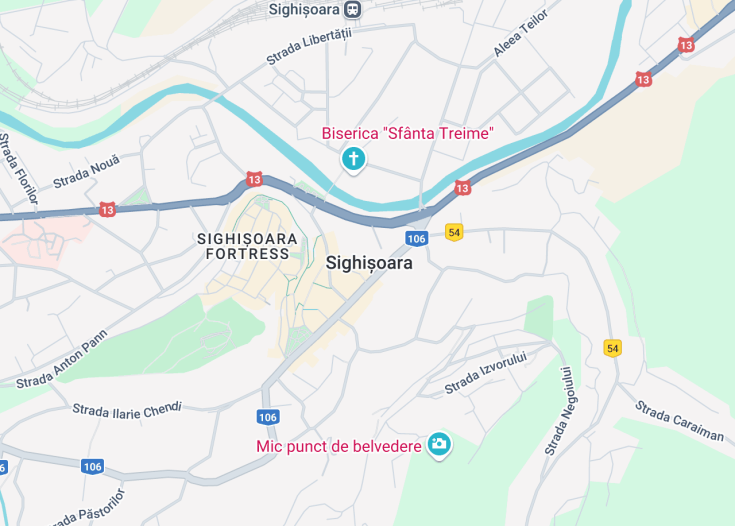Sighișoara, Romania, is a remarkable destination, renowned for its well-preserved walled old town, which is also a UNESCO World Heritage site. This medieval fortress, one of the last still inhabited in Europe, originally built in the 12th century by Saxon settlers, is famous for its cobblestone streets and ornate architecture.
Visitors can explore historical sites such as the Clock Tower, the Church on the Hill, and the house where Vlad the Impaler, reputed as the inspiration for Dracula, was allegedly born. Its captivating historical authenticity, vibrant cultural festivals, and remarkably preserved architectural details make Sighișoara a captivating destination for history enthusiasts and travelers alike.
Be sure to visit Sighișoara during its annual Medieval Festival. Held every July, the festival breathes life into medieval arts, crafts, and traditions, offering a unique and immersive experience.
Avoid driving within the old town as its narrow lanes are best explored on foot. Comfortable shoes are a must to navigate the cobbled streets comfortably and safely.
Sighișoara: A Journey Through Medieval Romania
| Country | Romania |
| Time in Sighișoara | GMT+2 |
| Language spoken | Romanian |
| Population | 28,102 (Romanian National Institute of Statistics, 2021) |
| Currency | Romanian Leu (RON, lei) |
| Airports |
|
Sighișoara, a preserved medieval citadel in the heart of Romania, boasts a striking beauty and a deeply historic atmosphere. Encircled by defensive walls and towered gates, its old town is a UNESCO World Heritage Site and the birthplace of Vlad the Impaler, informally known as Dracula. This historic gem offers a picturesque ensemble of cobbled streets, ornate churches, and centuries-old houses.
Highlights include the Clock Tower, standing as the main entry point and symbol of the city, the Covered Staircase leading up to the School on the Hill, and the Church on the Hill itself. Sighișoara hosts a vibrant medieval festival every summer, where the city blossoms with artistic performances, handicraft markets, and reenactments of medieval life, making it an enthralling time to visit for any history enthusiast.
Where is Sighișoara?
Situated in the historic region of Transylvania, Sighișoara lies perched on the Târnava Mare River in central Romania.
Distances:
| Route | Distance by car | Time by car |
|---|---|---|
| Bucharest to Sighișoara | 178 miles (287 km) | Approx. 4 hours 40 minutes |
| Cluj-Napoca to Sighișoara | 96 miles (155 km) | Approx. 2 hours 30 minutes |
| Brașov to Sighișoara | 71 miles (114 km) | Approx. 2 hours |
| Sibiu to Sighișoara | 55 miles (89 km) | Approx. 1 hour 40 minutes |
What is Sighișoara famous for?
Renowned for its well-preserved medieval architecture, Sighișoara is one of the few still inhabited citadels in Europe and the birthplace of Vlad the Impaler, the inspiration for Bram Stoker’s Dracula.
History
12th Century – Early Settlements
The history of Sighișoara dates back to the late 12th century when German craftsmen and merchants, known as the Transylvanian Saxons, were invited by the King of Hungary to settle and defend the frontier of the kingdom. The settlers established a thriving trading town here, utilizing the strategic position along important trade routes.
14th Century – Town Fortification
By the 14th century, Sighișoara had become a significant fortressed city with defensive walls and towers constructed to protect its inhabitants from potential invasions. The construction of the iconic Clock Tower, which came to be the symbol of the city, was also initiated during this period.
16th to 18th Century – Cultural Flourishing
During this era, Sighișoara experienced a cultural and economic boom. The city was known for its artisans and craftsmen, with various guilds playing a central role in its social structure. It also became famous for its schooling facilities, attracting scholars from across the region.
19th Century – Modernization
The 19th century brought about significant changes, with modernization and the arrival of the railway enhancing Sighișoara’s connectivity with other major cities, thus further boosting trade and cultural exchanges.
20th Century to Present
Sighișoara witnessed both World Wars’ impacts, which led to changes in its demographic and political landscapes. Post Second World War, under the Communist regime, the historical city faced numerous challenges. However, the post-1989 period marked the beginning of comprehensive restoration and preservation efforts, aimed at maintaining its rich historical legacy. Today, Sighișoara is revered not only for its well-preserved medieval architecture but also as a symbol of Romania’s diverse cultural heritage.
Visit Sighișoara
What to see and do in Sighișoara
Visitors to Sighișoara are greeted with a wealth of medieval architecture and historic sites that are sure to enchant any history enthusiast. Key attractions include:
- The Clock Tower, offering panoramic views of the city and housing the History Museum.
- The Church on the Hill, accessible by a covered wooden stairway, hosting ancient frescoes.
- The house where Vlad the Impaler, alleged to be the inspiration for Dracula, was purportedly born.
Additionally, exploring the city’s cobbled streets and vibrant squares provides insight into the ongoing vibrant local culture and art scene.[/p]
Festivals and Events in Sighișoara
Sighișoara hosts a variety of cultural events that reflect its rich heritage, notably the Sighișoara Medieval Festival in late July. This event features medieval music, street performers, workshops, and a traditional crafts fair, attracting both locals and tourists keen on experiencing the medieval spirit of the city.
Best time to visit Sighișoara
The best time to visit Sighișoara is from late spring to early autumn (May to September) when the weather is most pleasant, allowing for full enjoyment of the outdoor activities and the city’s festivals.
Is Sighișoara worth visiting?
Indeed, Sighișoara is worth visiting. The city is not only a stunning example of a well-preserved medieval fortified town but also offers a rich tapestry of history, culture, and festive experiences.
Its status as a UNESCO World Heritage site further underscores its global cultural significance, making it a must-visit destination for those traveling in Romania.









